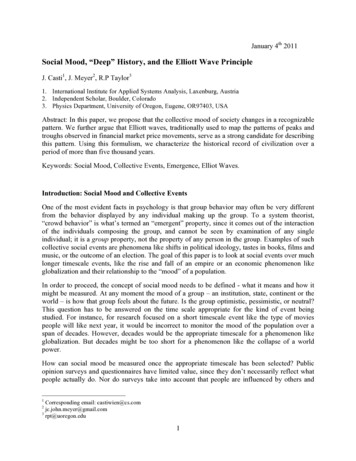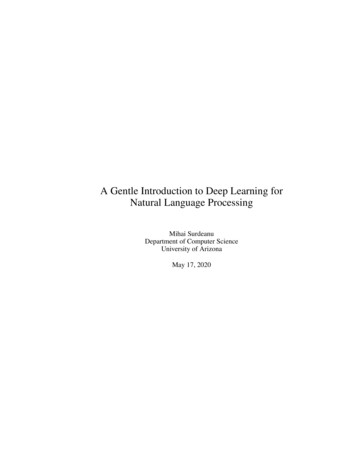
Transcription
January 4th 2011Social Mood, “Deep” History, and the Elliott Wave PrincipleJ. Casti1, J. Meyer2, R.P Taylor31. International Institute for Applied Systems Analysis, Laxenburg, Austria2. Independent Scholar, Boulder, Colorado3. Physics Department, University of Oregon, Eugene, OR97403, USAAbstract: In this paper, we propose that the collective mood of society changes in a recognizablepattern. We further argue that Elliott waves, traditionally used to map the patterns of peaks andtroughs observed in financial market price movements, serve as a strong candidate for describingthis pattern. Using this formulism, we characterize the historical record of civilization over aperiod of more than five thousand years.Keywords: Social Mood, Collective Events, Emergence, Elliot Waves.Introduction: Social Mood and Collective EventsOne of the most evident facts in psychology is that group behavior may often be very differentfrom the behavior displayed by any individual making up the group. To a system theorist,“crowd behavior” is what’s termed an “emergent” property, since it comes out of the interactionof the individuals composing the group, and cannot be seen by examination of any singleindividual; it is a group property, not the property of any person in the group. Examples of suchcollective social events are phenomena like shifts in political ideology, tastes in books, films andmusic, or the outcome of an election. The goal of this paper is to look at social events over muchlonger timescale events, like the rise and fall of an empire or an economic phenomenon likeglobalization and their relationship to the “mood” of a population.In order to proceed, the concept of social mood needs to be defined - what it means and how itmight be measured. At any moment the mood of a group – an institution, state, continent or theworld – is how that group feels about the future. Is the group optimistic, pessimistic, or neutral?This question has to be answered on the time scale appropriate for the kind of event beingstudied. For instance, for research focused on a short timescale event like the type of moviespeople will like next year, it would be incorrect to monitor the mood of the population over aspan of decades. However, decades would be the appropriate timescale for a phenomenon likeglobalization. But decades might be too short for a phenomenon like the collapse of a worldpower.How can social mood be measured once the appropriate timescale has been selected? Publicopinion surveys and questionnaires have limited value, since they don’t necessarily reflect whatpeople actually do. Nor do surveys take into account that people are influenced by others and1Corresponding email: n.edu21
don’t make their choices independently. After all, the very essence of social cohesion isclustering together, the very opposite of stand-alone, independent decision-making.In contrast, the financial market average is an effective measure of the social mood that reflectsboth actions and “herding” (Dreman, 1977). A market index like the Dow Jones IndustrialAverage (DJIA) in New York serves to characterize the “bets” people make about the future onall time scales. It is easy to obtain from the daily newspaper, has very little measurement error,and is available for very long periods of time – all highly desirable qualities for any practical“sociometer”. However, the historical events addressed in this paper occur over a time scale ofmillennia and therefore include eras when financial markets didn’t exist. It is then necessary tomove beyond financial markets and consider alternative indicators of social mood.Empirical evidence strongly suggests that the types of collective events that take place in periodsof positive social mood differ dramatically from what can be expected when the mood isnegative (Prechter, 1999, Casti, 2010). For example, when people are optimistic about the future(positive mood), everyday words like “unifying”, “liberating”, “togetherness”, “tolerant”, and“coming together”, describe the sorts of events that are likely to seen. Their opposites, labelssuch as “fragmentation”, “separation”, “restricting”, and “bigoted/xenophobic” characterizeevents that typically occur in times when the social mood is negative.An alternative sociometer for determining mood might therefore be found by examining thecharacter of historical events, and categorizing them according to the social mood (positive,negative, neutral) favoring such events. Previously, Robert Prechter carried out this procedurefor events recorded in history, and produced a chart of social mood spanning two thousand years.Here we extend this approach to map social mood across five thousand years. By doing so, weargue that the increases and decreases of this record in regard to social wealth can be explainedby Elliot waves – a pattern first described in the context of financial data by Ralph N. Elliott inthe 1930s (Frost and Prechter, 1978).Global Social Mood and the Process of GlobalizationTo begin the investigation, we illustrate the relationship between collective mood and collectiveevents by considering the specific phenomenon of globalization. Globalization is a label for aneconomic landscape that treats the world as one gigantic marketplace in which there is a freeflow of capital, labor, materials and ideas. As discussed in the introduction, during periods ofmaximum social mood, expected collective events are those labeled with words like “unifying”,“joining” and “expanding”. Globalization is similarly a reflection of positive social mood.Since the driving force behind globalization is, to a substantial degree, American corporations,the DJIA can be considered an indicator of the overall global social mood since the New YorkStock Exchange is the closest thing we have to a global financial market. The DJIA is shown inFigure 1 spanning the period 1975 to 2002. The observed background increase in the DJIA overthis period serves as a sociometer of the rise in positive social mood. Similarly, variations on topof this background serve as indicators of local peaks and troughs in the social mood.During this period of social optimism, a number of major milestones occurred on the path toglobalization, from the launching of the basic idea itself at the World Economic Forum in 19752
to the formation of the World Trade Organization (WTO) in 1996, to China’s joining of theWTO in 2000. These collective events are indicated in Figure 1. Note how these positive eventscoincide with peaks in the DJIA, supporting the argument that the occurrence of collectiveevents (in this case globalization) can be used as indicators of sociometers for social mood.Figure 1. The DJIA and Milestones in the Process of Globalization.This collective social phenomenon of globalization appears to be in decline. The longer termpicture shows that this global mood began to turn around in about 2000 and decreased steeply inlate 2007, beginning what is likely to be a decades-long decline that will lead to just the oppositetypes of collective events. Globalization will be replaced by localization, unification will bereplaced by fragmentation, and openness to strangers will be replaced by xenophobic behaviors.Early-warning signs of this shift have been apparent for several years (Saul, 2005) and are nowvisible almost every day in the mediaIn order to make this type of forecast of what’s likely to happen next, it is necessary to projectthe sociometer into the future. This means that a procedure to forecast the financial market3
averages is needed. In fact, there exist literally thousands of such procedures that have beendeveloped over the years [ Eng, 1988]. For the purposes of this paper, one of the most usefulprocedures turns out to be Elliott Wave Theory, which will be described in the next section.The Elliott Wave PrincipleThe fundamental pattern upon which the Elliott procedure rests is shown in Figure 2, whichdisplays a sequence of up and down price movements constituting a complete cycle of eightwaves. Typically, these waves are the ups and downs of a market indicator like the DJIA or theFTSE 100 Index on the London Exchange. Waves 1, 3, and 5 are called “impulse” waves, whilewaves 2 and 4 are termed “corrective” waves. So one complete Elliott cycle consists of eightwaves divided into two distinct phases: Numbered phases are in the direction of the main trend,while lettered phases move against the trend (Frost and Prechter, 1978 ).Elliott found that following completion of the above cycle, a similar but higher-level cyclebegins: Another five-wave up pattern followed by another down pattern of three wavescorrecting the up pattern. The overall situation is shown in Figure 3, while Figure 4 carries theidea through one entire market cycle. Figure 3 shows the crucial fact that each of the numberedand lettered phases is actually a wave itself, but of one degree higher than its component waves.The numbers shown in Figure 4 for the bull and bear cycles are the number of "cycle" waves,"primary" waves, "intermediate" waves, and so on present in the overall movement.Figure 2. The basic Elliott wave pattern.4
Figure 3. A major Elliott wave pattern, taken from Frost and Prechter, 1978Figure 4. A complete market cycle.The distilled essence of Elliott-wave formation consists of the following four principles:5
i. Action is followed by reaction.ii. Impulse waves subdivide into five waves of lower degree, while corrective waves subdivideinto three waves of lower degree.iii. A complete cycle consists of an eight-wave movement (five up and three down), whichthen becomes two subdivisions of the wave of next higher degree.iv. The time frame does not enter into the pattern, so that the waves may be stretched orcompressed along either the horizontal or the vertical axis without losing the underlyingpattern.How many cycles, sub-cycles, and sub-sub-cycles are there? The Wave Principle is hierarchicalin that each wave has component waves and is itself a component of a larger wave. Wavedegrees, or relative sizes, are denoted by names such as primary, intermediate and minor. Onceany wave is named by degree, all other degrees take on their roles as smaller or largerinterconnected structures. Elliott named nine degrees of waves, from those lasting centuries tothose lasting mere hours. The actual number of degrees may be infinite since the patterns showup even on one-minute graphs of aggregate stock prices and are likewise presumed to expandindefinitely into larger and larger degrees. To fix the labelling scheme in mind, here is theearlier chart on globalization including the Elliott wave labels for the Cycle wave V and Subcycle waves 1-5 (circle):Figure 5. Globalization and the DJIA Cycle wave V and Sub-cycle Waves 1-5 (circle).6
Historical CyclesHaving established he preliminary facts about social mood, sociometers and Elliott wave theory,we now turn to the employment of these ideas to study very long-term historical processes. Toget a truly long-term perspective on the flow of human events, Figure 6 shows the wave patterncharacterizing the social mood over a period of two millennia. From about 1790 onward reliablefinancial data is available, but for earlier times one must “reverse engineer” the situation. Asproposed in the Introduction, this means examining the character of historical events and placingthem as to the type of social mood that would be most likely to give rise to conditions favoringsuch an event. Prechter carried out this procedure for numerous events of all types alreadywritten onto the historical record, coming up with the chart shown in Figure 6. What'sremarkable is that although the prices shown in the chart are only a crude approximation togeneral price trends, a very long-term positive mood (bull market) can be seen to be beginning atthe end of the Dark Ages―a bull market we've been in ever since!Figure 6 . Millennia wave pattern for the past two thousand years.(Adapted from Fig. 18.7 in Prechter, 1999)This observation opens up the question of the millennium “bear market” that preceded this bullmarket. The best guess is that it began shortly after the death of Christ and continued for severalcenturies of misery ― disease, slaughter and stagnant social progress. The most importantfeature is the strong suggestion that the period of positive social mood that began around the year7
1000AD is now coming to a close. The millennium wave is still in its infancy, so we can expectit to last at least another thousand years and probably considerably longer.Figure 7(a). World Events from 3550BC to 2050BC.Figures 7(a)-(d) display the Elliott wave pattern for the period 3550BC to 2450AD, a span of sixmillennia. The pattern shown in the figures is derived from a long term chart found on p. 122 of(Frost and Prechter, 1978), which covered the period from 950 to l978. The authors used parishrecords of commodity prices from the eighteenth back to the twelfth centuries and estimated aprice increase from 950 to 1250. Since the decline from the end of the Roman Empire to 950 wasabout 500 years, we posit a total Elliott Wave of l500 years (l000 years up, 500 down.) Takingthe period from 950 to 2450 as a basic unit, we repeat it back in time for three cycles to cover theperiod 3550BC to 2450AD. All of the waves are identical in form. Notice that although WaveIV is the same shape as Waves II and VI, it is 200 years longer. Waves 1 and 2 of VIII are alsolonger than usual and waves 3, 4 and 5 are shorter. A period of 1500 years appears to be thelongest wave, unless we have finally achieved sufficient density to create a wave that is 4000years up and 2000 years down. But we won't know that for at least a thousand years! The chart isnot a mathematical function of any historical process, nor is it the result of a causal sequence.There is no cause and effect relationship between any historical event and the shape of the chart.The chart is an emergent property of distributed social processes acting over the course of time.8
Figure 7(b). World Events, 2050BC to 550BC.9
Figure 7(c). World Events 550BC to 950AD.It may be necessary to adjust the peaks of the waves as we learn more about the past, but as longas the basic shape (five waves up and three down) is maintained, the Elliott Wave Principle willnot be violated. In fact, one will notice a rather severe distortion of the horizontal scale for thelast 1000 years. Wave 1 of VII is 100 years too long, wave 2 is 50 years too long and waves 3, 4and 5 are shorter as a result. Notice also that the peak of Wave III has been moved back froml050BC to 1250BC, making the ensuing decline 700 years long rather than 500.10
Figure 7(d). World Events, 950AD to 2450AD.Finally, the wave pattern may not hold up as we go back in time. Elliott himself cautioned peopleusing his system not to try to apply it to individual stocks, since only the market as a wholeprovided sufficient volume of trading to generate a clear pattern. Thus there must be a minimumnumber of transactions before the wave begins to form. In terms of history, we would suggestthat there must be a minimum transaction density (rather than simply population density) togenerate the wave because similar populations could generate different numbers of transactions.Gwendolyn Leick’s description of Eridu (Leick, 2003) sounds like another 1500-year wavebefore the chart begins. This would take the pattern back to 5000BC. Thus there may be waves11
that continue well beyond the beginning of our chart, although there may only be waves ofsmaller and smaller degree as exemplified more recently by the patterns of empire in India,where allegiance to caste was stronger than allegiance to place or person. Except for theMauryas, the Guptas and the Mughuls, there were only minor states that seem to correspond tothe smallest subdivisions of the chart. The Mauryas peaked with wave 1 of V, the Guptas peakedwith wave 5 of V and the Mughuls peaked with Wave 3 of VII.Discussion of the chart’s relation to the historical record.Among some initial observations, the chart seems to reveal a rather significant lag in theunfolding of events. Notice that although King Menes united upper and lower Egypt at the peakof Wave 3 of I, it was not until towards the end of wave III in what is labeled the EgyptianMillennium that Egypt became preeminent. Likewise, although the first alphabets were made atthe peak of wave 3 of III and the Greek alphabet was complete at the peak of Wave III, it was notuntil the beginning of Wave V that the Greek philosophers began to explore the implications ofthe relationship between the written word and the real world. The rise of Chinese hegemony andphilosophy may show a similar pattern. Finally, the impact of the birth of Christ seems to bedelayed until what is labeled the Christian Millennium, from 950 to 1950.An interesting question concerns why the Babylonians abandon their cities at the end of wave III,Romans abandon their cities at the end of wave V and Americans abandon their cities at the endof wave VII? One possible explanation, a study published in The Lancet, (Lewis et al, 1992)found that a higher number of cases of schizophrenia among men living in cities than in thecountry was not the result of migration but was apparently caused by growing up in the city.Could high population density by itself cause emotional pathologies that result in theabandonment of cities?Notice that Biblical plagues occurred in wave A of IV, bubonic plagues and malaria in Rome inwave A of VI and AIDS in our own wave A of VIII. Could this be due to excess population inthe cities? Could disease be a cause for abandoning cities, at least in Babylon and Rome? Recentresearch in the field of paleopathology (Roberts and Manchester, 1995) should provideinteresting correlates to the chart. Even though the populations of these ancient cities were notsignificantly large nor significantly dense, the declines in population were severe, on the order offorty to fifty percent (McNeill, 1976). The climactic explosion of world population in the lastcentury, fueled by the redistribution of foods from the New World, implies a correspondingcollapse. A decline in population of ninety percent would not be out of the question.A disease such as AIDS would be the perfect mechanism for such a decline, partly because of itslong latency and partly because of our consistent underestimation of its virulence. Malaria isrebounding in the third world, drug resistant tuberculosis is spreading in large cities andparticularly in prisons, and is particularly hard to detect in patients with HIV/AIDS. Influenza iscapable of mutating into deadly forms, and as the plague outbreak in India in l994 demonstrated,all of these diseases are easily and rapidly spread worldwide by jet travelers. This kind ofdecimation would also be appropriate for the end of a four thousand year trend. Almost as aforecast, recent articles have focused on how we have reached the end of evolution as homosapiens, how we have subdued every selective mechanism (Ward, 1995).12
Then there is the matter of the importance of the waves of degree 3, at least in more recent times.Elliott points out that the third wave tends to be the most powerful, either in the main trend,where it is in the middle, or in a correction, where it occurs at the end. It can be argued that theRoman Empire peaked in the first century BC, at the end of wave 3 of V, even though Rome didnot fall for another 500 years. This was also the end of the Ptolemaic dynasty. At the end ofwave 3 of VII, the Ming dynasty ended and the Maya suffered their final collapse at the hands ofthe Spanish. At the end of wave iii of 5 of VII, however, five dynasties ended: the Manchu inChina, the Habsburg in Austria, the Hohenzollern in Germany, the Ottoman in Turkey and theRomanov in Russia. It was also about this time that Oswald Spengler conceived and wrote TheDecline of the West. The decline that he sensed was only wave iv, but it was quite real. Thisomission suggests that it might be rewarding to look more closely at the periods around the timeof King Menes (wave 3 of I) and of Abraham (wave 3 of III.) This is true also for waves ofdegree iii (particularly since Pericles lived at the end of wave iii of 1 of V.)The case of Charlemagne is especially interesting. He came to power at about the peak of wave iiof C of VI and attempted to rebuild the Roman Empire. But with all his talent and power, hecould not create a lasting dynasty. An interesting sidelight: The castles that were built inCharlemagne’s time by local nobility were not defenses against roving bands of marauders butdefense against Charlemagne’s own tax collectors. Charlemagne's heirs dissipated his work andit was not until after the end of wave VI, at 950 that Otto I was able to pull the Holy RomanEmpire together. From 962, it lasted nine hundred and fifty years (almost the entire length ofwave VII.). 950 was also the peak of infant abandonment in Europe and according to McNeil(McNeal 1976) a period of stabilization of epidemic diseases.Even numbered waves have their own appeal. The end of the decline during wave 2 of VIIproduced the religious reformation, which does not seem impressive until it is noticed that theend of the decline during wave 4 (l789) produced a political reformation. Perhaps there are otherperiods of reform during earlier waves of similar degree and during waves of smaller degree. Theschool of Stoicism was founded during wave 2 of V (235 to l50BC) and recurred during wave 4of V (Domitian’s banishment of philosophers from the Roman capitol would certainly seem toencourage Stoicism.) Natural law, which grew out of Stoicism, became prominent during wave 2of VII and again during wave 4 of VII. During the decline since the beginning of wave VIII(l950) there has been an explosion of interest in natural law. Preoccupation with all kinds of lawduring downtrends may be an attempt to restore cooperation. The theoretical aspects of law maybe most interesting when its practice is being neglected. In terms of an innovation-exploitationaxis, periods of decline may generate new theories of law, which are applied during upwardtrends.One of the most interesting aspects of the chart is the way in which every philosophical orreligious flowering, with two exceptions, begins at the end of an even numbered wave. It may bedifficult to trace this phenomenon beyond about 700BC, or if the Iliad counts at the end of waveA of IV, but beginning at the end of wave IV almost every major world philosophical system(Karl Jaspers’ “Axial Age”) (Jaspers, 1949) from the Buddha to the major Greek philosophers toZoroaster, are all clustered around 550BC. Mohammed occurs at the end of wave A of VI; theCluniac revival, or Catholic reformation, occurs at the end of wave VI; The Protestant13
Reformation occurs at the end of wave 2 of VII; and political reformation with the French andAmerican revolutions occurs at the end of wave 4 of VII. Two exceptions are the birth of Jesus atthe peak of wave 3 of V, and the birth of Hinduism at the end of wave 3 of III. The birth of Jesusjust happens to be the point of transition from the age of Aries, the ram to Pisces, the fish,perhaps the origin of the Christian fish. In fact, the Christian bible did not begin to be writtenuntil the end of wave a of 4 of V, another bottom.The long waves seem to have an interesting connection with warfare. Beginning with the low atthe end of wave II, each major uptrend is dominated by a single weapon system that does notbecome established until the end of wave l. Before the end of Wave II, about 2000BC, warfarewas highly ritualized and relatively inefficient. Wave III is dominated by the chariot and therecurve bow, supplemented by knowledge of anatomy and cattle driving gained by nomadicherdsmen as described by John Keegan in The History of Warfare. (Keegan, 1994) Although footsoldiers were dominant during wave 1, Wave V is dominated by the oared warship, appropriatefor empires built on Mediterranean sea trade (foot soldiers were again dominant in wave 1,probably because the Greeks did not have good terrain for chariots.) Wave VII was dominated bygunpowder, (although the crossbow was the weapon of choice for most of wave l) and peakedvery appropriately with the hydrogen bomb.There would seem to be some kind of connection between the bottom of wave VI (950), thebottom of wave 2 of VII (1500) and the bottom of wave 4 of VII (1789). The first was theconnection between the Roman Reformation (the Cluniac Revival) around 950, the ProtestantReformation around 1500 and a secular Reformation with the American and French Revolutions.These were followed in turn by the Roman Crusades, The Protestant (and Roman Catholic)evangelical Crusades to save the heathen of the whole world and finally a secular (sort of)Crusade to save the World from Fascism and then “godless” Communism. The flip side of thedesire to save the world is the fear that someone else is going to do it first, leading ultimately toparanoia. There was also the Roman Inquisition (wave 1); the Spanish Inquisition (wave 3); andwhat might be called a Secular Inquisition, or Fascism, (wave 5).Finally, the waves seem to have a profound effect on the apparent quality of leadership: in oddnumbered waves even mediocre leaders have some success, while brilliant leaders shine. Noticethat all of the Queens of England ruled during up trends. In even numbered waves, even brilliantleaders are beset with trials, while mediocre leaders simply do not last. Again, leadershipchanges frequently during downtrends but more infrequently during up trends. There is enoughdata on dynasties both East and West that this should be a good test of the wave pattern.Discussion and ConclusionsThe arguments presented here certainly raise more questions than they answer. But the onequestion they do answer is whether history has a pattern. Of course, the idea of historical patternsis nothing at all new, since by definition, history either has a pattern or historical events aretotally random. There is no in-between. What matters, then, is the type of pattern. The argumentpresented here strongly suggests that the Elliott wave patterns seen in financial market pricemovements serve as a strong candidate for the patterns of history, as well. But accepting this14
claim as a working hypothesis opens up many questions standing in the way of transformation ofthe hypothesis into an actual theory. Let’s look at a couple of them: How do we effectively measure the social mood in times prior to the existence offinancial markets? How do we best label the various waves, sub-waves, sub-sub-waves et al in the Elliottscheme to get the “right” wave count for an historical period? What is the time lag between a turning point in social mood and its consequent impact onhistorical events? Can we develop a dynamical system-theoretic model for the change of social mood? What other factors need to be integrated together with social mood, in order to serve asearly-warning indicators for historical discontinuities? Some have argued that “social capital” also enters into the dynamics of historical events.Are social mood as defined in this paper and social capital correlated? And if so, in whatway and to what degree? The work presented in (Turchin, 2006) is very relevant to thisquestion.A leading candidate for the most important question on the foregoing list is the mechanism forthe change of social mood. How, exactly, does the mood of a population of heterogeneousagents, interacting in a continually-changing dynamical network of connections, give rise tochanges in the ongoing social mood? And how do we characterize when we are nearing a“tipping point” of social mood?Finally, we have the biggest question of all: Does this work help us better understand historicalprocesses? Our answer is that if you have a procedure that can reliably forecast future trends, andif that forecast is based upon principles that respect known behavioral patterns of humaninteraction, then you have a procedure that helps in understanding the dynamics of historicalevents. The ideas presented here rely upon the interaction of human beings to form a collectivesocial mood, the view a group/society holds about the future. That is the foundation of ourtheory. We further argue that that mood changes in a recognizable pattern, the Elliott wavestructure and that that pattern can be forecast, at least in broad outline. Of course, much workremains to refine and elucidate these factors into something that begins to look like a scientifictheory. But the scaffolding is here. What remains is to build the superstructure.ReferencesCasti, J. (2010). Mood Matters. New York: Copernicus.Dreman, D. (1977). Psychology and the Stock Market. New York: AMACOM.15
Eng, W. (1988). The Technical Analysis of Stocks, Options, and Futures. Chicago: ProbisFrost, A. and R. Prechter. (1978). Elliott Wave Principle. Gainseville, GA: New ClassicsLibrary.Jaspers, K. (1949). Vom Ursprung und Ziel der Geschichte (1st ed.). München: Piper Verlag.Leick, G. (2003) Mesopotamia, London: Penguin.Lewis, G., A. David , A., Andréassson, S.Allebeck, P. (1992), Schizophrenia and city life , TheLancet, Vol. 340, Pages 137 - 140Keegan, J. (1994), A History of Warfare, Vintage, NY; edition 1McNeill, W. (1976). Plagues and Peoples. Garden City, NY: Anchor Press/DoubledayPrechter, R. (1999). The Wave Principle of Human Behavior and the New Science ofSocionomics. Gainseville, GA: New Classics Library.Roberts, C. and Manchester, K. (1995). The Archaeology of Disease. USA: Cornell UniversityPress.Saul, J. (2005). The Collapse of Globalism. New York: Penguin.Turchin, P. (2006). War and Peace and War. New York: Penguin.Ward, P., (1995) The End of Evolution: A Journey in Search of Clues to the Third Ma
procedures turns out to be Elliott Wave Theory, which will be described in the next section. The Elliott Wave Principle The fundamental pattern upon which the Elliott procedure rests is shown in Figure 2, which displays a sequence of up and down pric











